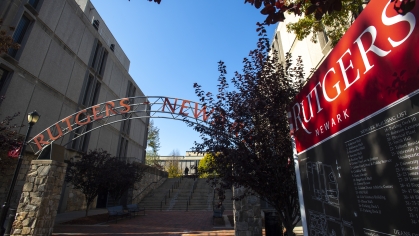Rutgers University–Newark has been designated an Opportunity College and University, a category created for the first time by the Carnegie Classification of Institutions of Higher Education to recognize schools that excel at helping economically disadvantaged students find careers that pay competitive wages.
Rutgers-Newark was among 478 schools nationwide selected for the designation. “The majority of students apply to college with the hope it is a path to opportunity, and the job they’ve dreamt about,” said Timothy F.C. Knowles, president of the Carnegie Foundation. “This work is about ensuring that institutions are recognized when they empower students to reach their goals and succeed.”
The recognition comes as U.S. News & World Report named Rutgers-Newark #5 nationwide and #1 in New Jersey for Social Mobility for the second year in a row. Rutgers-Newark has accomplished these standings while also being recognized as a top 40 public institution (#36), based on metrics that include higher graduation rates compared to the national average, lower student debt upon graduation, lower faculty-student ratios, and competitive faculty salaries.
For Rutgers-Newark undergraduates who received financial aid and earned their degree within 10 years of enrolling, the median salary was $74,500, according to the Department of Education, whose data was used as the basis of the Carnegie evaluation. Rutgers-Newark graduates make $20,752 above the median for graduates of four-year colleges and universities nationally, according to department data. Ninety-two percent of Rutgers-Newark graduates were working full-time or continuing their post-secondary education within six months of graduation.
Said Rutgers-Newark Chancellor Tonya Smith-Jackson, “This recognition by Carnegie as an Opportunity Institution reaffirms the critical role RU-N plays in advancing social mobility, research excellence, and economic impact. At a time when the value of a college degree is questioned, these distinctions validate that our graduates and our scholarship deliver measurable outcomes: transforming lives, driving innovation, and strengthening communities. The American dream can be achieved right here at Rutgers-Newark,''
Since 1973, the Carnegie Classification has been the leading framework for organizing and describing colleges and universities in the U.S. But this is the first year the foundation, which now partners with the American Council on Education, began identifying institutions according to the Student Access and Earnings Classification (SAEC), which was used to pinpoint schools recognized as Opportunity Colleges and Universities.
The SAEC examines the extent to which an institution is enrolling undergraduate students who reflect the communities that the school serves and whether those students go on to earn competitive wages compared to others. It recognizes schools where there are a large number of students eligible for Pell Grants, which are available to low-income students, and correlates that with their earnings after graduation. At Rutgers-Newark, 56% of students are Pell eligible.
The Opportunity College and University designation represents a wide variety of institutions of all sizes, locations, and types as drivers of opportunity for students.
“Hundreds of institutions nationwide are providing students an excellent opportunity to use higher education as a springboard to a better life,” said Ted Mitchell, president of ACE. “The Student Access and Earnings Classification highlights the depth and breadth of schools where student success is front and center.”



